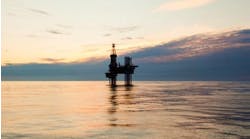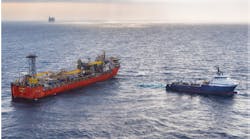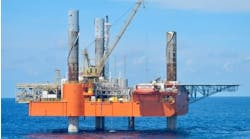Andy Weatherhead
Rockwell Automation
Technology continues to evolve at a record pace, causing oil and gas producers to increasingly rely on a secure, robust communication network to support exploration, production, and wellhead operations. Transitioning to a digital oilfield is paramount for these companies to help realize and establish an effective connected enterprise and continue to drive innovation both offshore and onshore.
This transition relies on new technologies, such as mobile devices and the cloud, that already enable a myriad of other applications to connect production with enterprise systems for greater output, better use of assets, and improved decision making.
As new digital technologies are continually cultivated and implemented into daily operations, oil and gas companies need a way to better access, understand, and analyze the wealth of data coming from these assets. Remote-monitoring solutions can now unlock well diagnostics and other real-time data generated by countless intelligent devices.
With this increased data access, oil and gas operators can translate important asset-management information to optimize production, and reduce downtime, unplanned maintenance, well visits, and other operational costs.
Remote monitoring
Traditionally, accessing information from pumps, lifts, wellheads, and other equipment was a labor-intensive process. Onshore, workers had to drive from platform to platform and physically gather data. Offshore, one person stationed at each platform monitored performance. Field engineers made assumptions regarding the actual oil and gas, such as pressure, the amount being pumped, etc., at each platform. These procedures not only put people at risk, but also they were time-consuming and introduced the potential for data tainted by human error.
That is why automation providers are bridging the information gap with fully automated and integrated systems to help capture and send data from a remote site to a centralized location. Oil and gas companies can now remotely access and monitor machine data and oil and gas analytics by leveraging wireless communication and visualization solutions. As the benefits of automation, communications and information technology converge, these wireless solutions help merge disparate oilfield data into streams of actionable information, regardless of the source.
By investing in digital oilfield remote-monitoring technologies, operators can access and manage equipment, production data, and asset analytics across multiple applications from one single location, which can be hundreds or thousands of miles away from the platform itself. This technology seamlessly integrates software, hardware, and sensors to extract important operational information – such as daily oil production, energy usage, oil pressure, and more – across a variety of wellhead applications and feeds it back to a centralized location in real time. Operators can then continuously monitor current operating conditions, troubleshoot any potential issues, and make process adjustments at an earlier stage to help increase uptime – all without leaving their workstation. They are also able to more accurately monitor their most critical asset to rationalize what is coming out of the ground, effectively allocate resources, predict changes in well data, and make assumptions based on the continuous process data variables.
Abu Dhabi Marine Operating Co. (ADMA-OPCO) was looking to increase production from its offshore operation. Many of the company's operating fields contained a large number of water-injection wells. Without access to offshore data, reservoir engineers could not properly manage the water-injection process. The company attempted several times to install wireless supervisory control and data acquisition systems, but they were unreliable and unable to deliver data from wells more than 20 km (12 mi) from the main platform.
ADMA-OPCO worked with Rockwell Automation company vMonitor to design and implement the oil company's first successful water-injection wireless remote-monitoring system. The new system tracks well pressure, temperature, and flow, and efficiently delivers the data to the main platform. This is the first wireless telemetry system for ADMA-OPCO capable of capturing data from these distant wells. The increased access to water-injection data helped the company to increase production and reduce well visits by more than 60%.
Prevent data deluge
Although remote monitoring helps optimize production, oil and gas companies must beware of information overload. As the amount of asset-related information swells, operations personnel may become overwhelmed.
To avoid information overload, operations-management solutions can be used to help convert data from across the digital oilfield platform into easy-to-comprehend information. Beyond remote monitoring, these systems gather, analyze, contextualize, and share information to help oil and gas producers optimize operations. By pairing production intelligence with intuitive dashboards and historian functionality, operations-management systems can automatically collect production data, calculate key performance indicators, and present easy-to-understand displays via wireless, remote technology.
In addition, applying operations-management solutions offers an alternative to data deluge by supporting collaborative environments where remotely located subject matter experts make decisions and trained operators apply their recommendations. Automation providers offer remote-service support to delegate data collection and analysis, troubleshooting and maintenance activities to centrally-located automation professionals. Diverting information to off-site experts can help operators focus their time on maintaining a smooth, on-site operation.
By applying working information capital across the digital oilfield, oil and gas companies can leap from simply linked operations to smart, connected enterprises. To further enhance connectivity and productivity into the future, many companies are leveraging the cloud to deploy remote-monitoring and operations-management solutions.
Cloud technology
Just as the cloud has helped revolutionize banking, telecommunications, and back office business services over the last decade, it is now helping oil and gas companies construct the digital oilfield by providing an alternative option to traditional on-premise infrastructure offerings. Primarily, cloud technology eliminates the need for capital investment to design and maintain a physical data-storage infrastructure, especially for small- to medium-sized companies that do not have the budget to invest in their infrastructure.
The cloud acts as a common, secure environment to protect oil and gas systems, and can seamlessly and remotely link end-point devices across the digital oilfield – from a remote terminal unit (RTU) or offshore wellhead to a mobile device in the field – for an effective connected enterprise.
Much like cell phone users, oil and gas companies can store data from RTUs in the cloud, making the information readily available whenever and wherever it is needed. Even equipment and device configurations can be saved and backed in the cloud. For example, if an RTU fails and a new piece of equipment is required, companies will have the proper configuration and application settings saved and available for immediate download.
Apart from simply storing data, the cloud also is readily scalable and supports other transformative technologies, such as mobile computing, the industrial Internet of Things, and advanced analytics. In the coming years, cloud-based systems will give oil and gas companies the expanded ability to perform analytics on the data that is already being collected, displayed, and consolidated in the digital oilfield. These companies will be able to incorporate analytics-based decision making in their processes – improving predictive maintenance, enabling improved asset utilization, and reducing risk and operations costs.
Transforming to a digital oilfield
The foundation for achieving the digital oilfield begins with planning, designing, and applying remote-monitoring and operations-management solutions. By working with an automation provider, oil and gas companies can decrease costs and risks associated with the traditional, labor-intensive, data-collection processes.
Remote-monitoring solutions help oil and gas producers visualize their operations with real-time, comprehensive data that is easily transformed into actionable information to help achieve goals of reduced downtime and increased productivity. Through cloud computing, these solutions are not only applied quicker, but also are more easily scalable as other transformative technologies emerge in the future.
By remotely tapping into the full range of production and operational data, and diverting that information to off-site experts, companies can start to realize the full potential of the digital oilfield.






